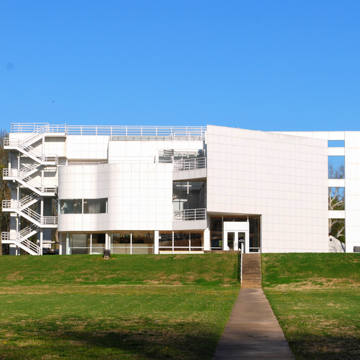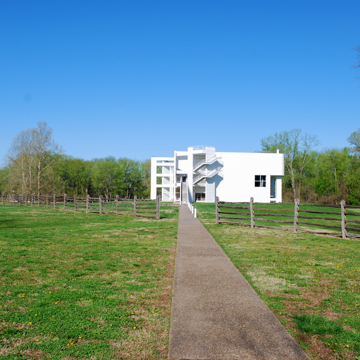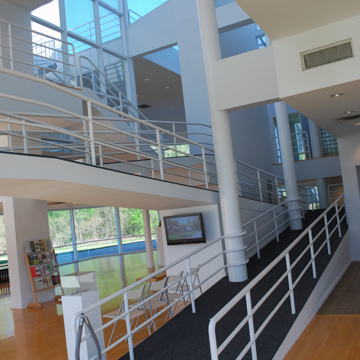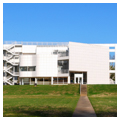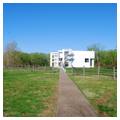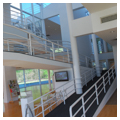You are here
The Atheneum
On the east bank of the Wabash River is the visitor and cultural events center for the community of New Harmony. It serves as the starting point for tours of the former utopian community. Designed by noted architect Richard Meier, it was built between 1976 and 1979 and funded by grants from the Krannert Charitable Trust and Lilly Endowment of Indianapolis.
The Atheneum is a building that encourages exploration and challenges established definitions and perceptions of space, much as the Harmonist and Owen movements challenged established definitions of community. While unabashedly stark, the three-story building clad in white porcelain steel-backed panels is intertwined with the landscape, taking its cues from both the natural and manmade, its undulating west elevation recalling the contour of the adjacent river and its rigidly formal east elevation a nod to the gridded plan of New Harmony. The building is dynamic, both in terms of shifts in grids and planes and in the plays of shadow and light that alter perception of the space as the sun passes over and penetrates into the building.
The procession through the building is finite but fluid. Internal circulation is facilitated by a ramp that ascends from the openness of the first-floor public spaces through a series of wall planes, grids, and columns set in an intricate matrix so arranged as to provide carefully controlled views through the space and beyond it, onto the landscape and the community. This is balanced by the exterior staircase that threads upward, which contributes to the dynamic and unexpected relationships of space that define the building and its juxtapositions of solid and void and rigid and fluid. The culmination is the terrace, offering views of the town from which the building emerges as a progressive counterpart, harkening back to the spirit of New Harmony’s founders. So prepared, one passes from the building and into the landscape and the remaining portions of the village crafted by the Harmonists.
In 2008, the building won the AIA Twenty-five Year Award, praising the timelessness of Meier’s design, which is at once radical and sympathetic. Indeed, rooted in an expressed purity of modernity that has pervaded much of Meier’s work first cemented in his associations as part of the New York Five, the Atheneum became a seminal work representing the stark divide between a radical ideological modernism that reveled in a pure architectural form grounded in a Corbusian dialogue above all other concerns and the reactionary postmodernist school that found merit in a contextual template. Its impact when it first opened was well captured by Ada Louise Huxtable in 1979: “On the banks of the Wabash River, not far from the corn fields of Indiana, stands a dramatically handsome new building representing architecture’s most advanced frontier. This gleaming white structure is as radical an addition to the rural American heartland as Le Corbusier’s Villa Savoie was to the French countryside at Poissy half-a-century ago.” Yet, within this radical form is the sympathetic contextual undertone. Entrenched in a distinct spatial awareness, the Atheneum harmonizes concepts of plasticity and place, a sense of community and of an intrinsic self-awareness of its location in New Harmony, a place that is at once both radical and embedded in the past.
References
“The Atheneum.” Richard Meier & Partners Architects. Accessed April 18, 2018. http://www.richardmeier.com/.
“The New Harmony Athenaeum: Richard Meier Interviewed by Ben Nicholson. March 25th, 2010, New York.” Archinect. Accessed April 18, 2018. http://archinect.com/.
Writing Credits
If SAH Archipedia has been useful to you, please consider supporting it.
SAH Archipedia tells the story of the United States through its buildings, landscapes, and cities. This freely available resource empowers the public with authoritative knowledge that deepens their understanding and appreciation of the built environment. But the Society of Architectural Historians, which created SAH Archipedia with University of Virginia Press, needs your support to maintain the high-caliber research, writing, photography, cartography, editing, design, and programming that make SAH Archipedia a trusted online resource available to all who value the history of place, heritage tourism, and learning.














